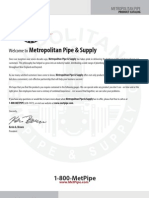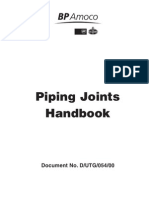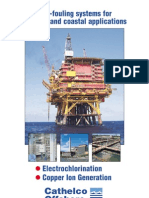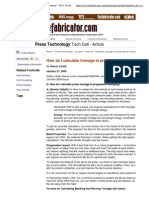0 ratings0% found this document useful (0 votes)
987 views3D & 5D Pipe Bend For Pipeline
3D & 5D Pipe Bend For Pipeline
Uploaded by
mohammadazraiInduction pipe bending has several advantages over traditional cold bending or elbows, including free-shape processing without dies, high accuracy due to minimizing springback during hot bending, and ability to bend heavy-walled pipes to small radii. The document provides details on the induction pipe bending process, applications in various industries, development of high-grade bends, and use of a weldless piping system to reduce costs and improve quality.
Copyright:
© All Rights Reserved
Available Formats
Download as PDF, TXT or read online from Scribd
3D & 5D Pipe Bend For Pipeline
3D & 5D Pipe Bend For Pipeline
Uploaded by
mohammadazrai0 ratings0% found this document useful (0 votes)
987 views6 pagesInduction pipe bending has several advantages over traditional cold bending or elbows, including free-shape processing without dies, high accuracy due to minimizing springback during hot bending, and ability to bend heavy-walled pipes to small radii. The document provides details on the induction pipe bending process, applications in various industries, development of high-grade bends, and use of a weldless piping system to reduce costs and improve quality.
Original Description:
3D & 5D Pipe bend for pipeline
Original Title
3D & 5D Pipe bend for pipeline
Copyright
© © All Rights Reserved
Available Formats
PDF, TXT or read online from Scribd
Share this document
Did you find this document useful?
Is this content inappropriate?
Induction pipe bending has several advantages over traditional cold bending or elbows, including free-shape processing without dies, high accuracy due to minimizing springback during hot bending, and ability to bend heavy-walled pipes to small radii. The document provides details on the induction pipe bending process, applications in various industries, development of high-grade bends, and use of a weldless piping system to reduce costs and improve quality.
Copyright:
© All Rights Reserved
Available Formats
Download as PDF, TXT or read online from Scribd
Download as pdf or txt
0 ratings0% found this document useful (0 votes)
987 views6 pages3D & 5D Pipe Bend For Pipeline
3D & 5D Pipe Bend For Pipeline
Uploaded by
mohammadazraiInduction pipe bending has several advantages over traditional cold bending or elbows, including free-shape processing without dies, high accuracy due to minimizing springback during hot bending, and ability to bend heavy-walled pipes to small radii. The document provides details on the induction pipe bending process, applications in various industries, development of high-grade bends, and use of a weldless piping system to reduce costs and improve quality.
Copyright:
© All Rights Reserved
Available Formats
Download as PDF, TXT or read online from Scribd
Download as pdf or txt
You are on page 1of 6
Characteristics of Induction pipe bending
Induction bending enables precision control of the conditions for heating
and cooling narrow sections of steel pipe to ensure more stable quality and
shape. Accordingly, it has many advantages over cold bending or the use
of elbows:
1)Free-shape processing
No bending die is needed to process any bending radius or angle. S-
bends, such as detoured conduits, and those with three-dimensional or
multiple bends are also possible.
2)HighIy accurate processing
The use of hot bending ensures that any spring-back affecting the bend ra-
dius and angle can be minimized to assure stable dimensional accuracy.
3)SmaII-radius bending of heavy-waIIed steeI pipes
Heavy-walled pipes for high-pressure steam piping can be bent to a small
radius by controlling the processing conditions, such as the heating tem-
perature and cooling speed.
4)Bending for even mechanicaI properties e.g. strength and
toughness
High-grade bends are available by applying methods of processing in con-
sideration of material characteristics and by meeting the mechanical re-
quirements e.g. the values of strength and elongation.
Scope of high-frequency bending
Material : Carbon steel, Alloy steel, Stainless steel, Aluminum, Titanium,
Hastelloy, Cupronickel, etc.
Standard : API , ASTM, JIS, ISO,BS etc.
Size : Pipe Outside-Diameter : Maximum. `
Shaped steel Size : Maximum 900mm-H
Wall-Thickness : Maximum 130mm
Bending Radius : 1.5DR, 2DR, 3DR Max.400ft
OutIine of Bending Method
The Pipe clamped on the arms is gradually local induction heated from
O.D. pushing foward at a constant speed, so that bending stress is con-
centrated at the heated zone, and continuously deformed to product.
HiQh-frequency converter
Arm
CoolinQ
Clamp
Feed lenQth
Clamp lenQth
lnduction
heatinQ coil
Tailstock DrivinQ Qear
Guide roller
Variable arm
H
endinQ
H
adius
Oil pressure cylinder
Various heavy-duty anti-corrosion coatings are used for underground pipelines depending on the environments and operational
conditions under which they are laid. DHF's polyethylene coating technology is highly appreciated for its 40-year-service. DHF
has also developed other anti-corrosion products by making the best of the induction heating technology to meet market needs,
which have included high-frequency bends with their exteriors coated with materials other than polyethylene.
Coating material: Polyethylene, Fusion Bonded-Epoxy etc.
ExternaI anti-corrosion coated pipe suitabIe for underground piping
DHF Induction Pipe Bend for pipeIine
Material : API 5L Gr.B X 80, Weldable 13Cr steel, Duplex, Stainless steel, Clad Pipe, etc.
Pipe Size : 1" 48"
Bending Radius : 3DR, 5DR, 10DR.Minimum:1.5DR Maximum.400ft-R)
PoIyethyIene coating Bends for Gas Iine
DHF Bend & PoIyethyIene coating pipe
for gas transmission Iine
Gr.
X60
X65
X70
X80
Wall thickness(mm)
-20/70J
10 20 30 40 50 60 10 20 30 40 50 60
Wall thickness(mm)
-40/70J
36.5
20.6
36.5
17.5
Fig. AppIicabIe bending size for UOE pipe
TechnoIogy to manufacture bend pipes
Bend pipes for use in pipelines are manufactured in accordance with multiple specifications con-
sidering operational environments and conditions, as well as with due consideration for material
design and manufacture through dimensions and shapes to non-destructive inspections (NDI).
DHF defines processing conditions based on years of experience in production and accumula-
tion of testing data to provide bent pipes with appropriate heat history, stable strength, and
toughness.
1)TechnoIogy to improve materiaI strength characteristics
In bend pipes, specific processing with rapid heating and quenching is conducted to provide
products with a stable material structure. DHF has established its tempering-less bending tech-
nology for steel pipes of up to API 5L X 65 grade intended for line pipes and its products are em-
ployed as bends for use in domestic gas trunk lines. The application of its technology has also
realized alloy or stainless steel clad bends which have garnered a high reputation for expertise
in its field.
2)High-grade bend deveIopment
Higher-grade requirements for gas pipelines up to X 100 have accelerated for thin-walled but
high-strength products and higher operational pressures. DHF has promoted research and de-
velopment to meet these market needs, providing high-grade bends made of API high tensile
steel, Duplex stainless steel and weldable 13Cr steel for more severe corrosive environments.
3)TechnoIogy to improve the bending process
DHF's process technology enables bends to have material characteristics obtained by bending
them under continuous heat treatment conditions without separating the tangent and bent sec-
tions in accordance with specifications.
Heavy Pipe Bend
Material : ASTM A106, ASTM A335, A312, A333
ASME T23, P91, P92
Pipe Size : 1" 30"
Wall-Thickness : Maximum 130mm
Bending Radius : 1.5DR 3DR 10DR
1.5DR BENDS for NucIear power pIant
ASTM A312 TP316L 24"` 38.6mm` 914.4mmR
1.5DR BENDS for ThermaI power pIant
ASTM A106 18"` 82mmT`685.8mmR
Heat history in Induction pipe bending is similar to that for heat treatment of steel. Carbon steel and low
alloyed steel are induction-heated to the normalization temperature and stainless steel to the solution
heat treatment temperature, bent within the hot plasticity area, and then immediately quenched. In prin-
ciple, the cooling method is selected in accordance with the material quality and required quality. How-
ever, water-cooled bending is adopted for radii of 2 DR or smaller in order to retain the bent shape and
post heat-treatment is applied necessary.
When bending a steel pipe to a small radius, wall thickness of extrados decreases while intrados increa-
ses. Using DHF's high-frequency bending, special "technology to inhibit reduction of wall thickness using
compression stress control" and "technology to control tapering in increased wall thickness areas at the
start and end of the bend" have been established. These technologies, as adopted for high-pressure pip-
ing, enjoy a high reputation.
(1) AppIication of the optimum bending and heat treatment conditions according to materiaI
(2) TechnoIogy to inhibit waII thickness reduction using compressive force
(3) Smooth controI of increase or decrease in waII thickness at the start and end of the bend
(4) FIattening controI technoIogy
WeIding service for Power pIant piping
RentaI Machine for site bendingWeIdIess piping system at site)
Site Bending Service by RentaI Bender
* Mobile induction bending machine is available as rental bender service.
* Rental bending machine is dispatched and installed at plant site during construction.
* DHF's technical advice based upon experienced and accumulated knowhow can offer you a remarkable cost reduction.
* Weldless Piping System by using DHF's site bending service can be widely used in industrial plants.
Site Bending Service
Material : Carbon Steel, Stainless Steel, Low Alloyed steel. etc.
Outside Diameter : 2"16" Bending Radius: 1.5DR,A2DR, 3DR
Supply Record of Rental Bender : Bangladesh, Indonesia, Japan, Malaysia, Qatar, Singapore, Taiwan, Thailand, Venezuela
Conventiona| e|bow
and tees piping
Conventional elbow
and tees piping
Weldless piping
DHF bend and
B.C piping)
Comparison of number of we|ds
Number of welds: 16 Number of welds: 3
100,
55,
17,000
9,500
17,000
10,000
5,000
N
u
m
b
e
r
o
f
w
e
ld
s
DHFs piping system
We|d|ess piping)
DHF bend and B.C piping Field
welding
Field
welding
shop
welding
shop
welding
Induction bend pipes can meet various material requirements and adopt any bending radius and angle as well as multiple bends
as required for use in applications for various and diverse industries and piping systems.
WeIdIess piping system
for reducing manpower and construction term, as
weII as improving quaIity
The use of bends in place of elbows saves on labor in plant piping construc-
tion and cuts the number of welds needed. DHF provides petrochemical,
power plants, and various other areas with its "weldless piping system". By
reducing the number of welds, it is able to bring about many advantages, such
as reduced welding and inspection costs, hydrostatic test, and construction
term. Piping defects are mostly found with welds, and reducing the number of
welds improves piping quality, therefore, our weldless piping system is highly
evaluated as a way to cut labor costs on piping construction.
Bending radius Industry ExampIes AppIicabIe materiaI
1.5DR3DR
3DR5DR
5DR15DR
Special shape
Special applications
Carbon Steel/Stainless steel/Low Alloy
Carbon Steel/Low Alloy
Carbon Steel/Stainless steel/Low Alloy
Stainless Steel
Stainless Steel/Aluminum Killed Steel
Carbon Steel
1% Cr
Petroleum refinery, petrochemical
Environmental equipment, area-wide air conditioning
Foods, medicines
Store
Shipbuilding,
Floating Production Storage Offloading (FPSO)
Miscellaneous
Fertilizer
Refuse disposal, sludge disposal
LNG, LPG
Marine piping
* * * *
Cargo oil pipe
Petrochemical Terephthalic acid plant Titanium
Petrochemical Pellet transport, powder transport Stainless Steel
Petroleum refinery
Gas treatment
CCR heating furnace tube
Reformer
Ethylene/naphtha reaction tube
Inconnel, 9 Cr
Incolloy, stainless steel
Centrifuge-cast pipe
Interior-finned tube
Petrochemical Heat-insulation pipe Duplex tubes with stainless and carbon steels
Bending AppIication
Material : Carbon Steel, Stainless Steel, Aluminum etc.
Shape : H Beam, Angle, Channel, Square Pipe, Rectangular Pipe, Bar
Example :
H beam size : Max.9001
Bending Radius: H100`100 6/8mm 250mmR
H600`200 11/17mm 3500mmR
Square Pipe 200`200m 9.0mm-thickness
H Beam 498`432m 45/70mm-thickness
Shaped steeI bend is used for;
Structure, Reinforcement of civil construction, Monument,
Sign board pole, Roller coaster, Pedestrian bridge etc.
Advances in CAD now allow for the use of many curves in structures. Conse-
quently, DHF's bends support the free design and creation of a wide range of
beautiful structures: aqueducts, pedestrian bridges, bridge footing arches, roof
beams for stadiums, stations, pavilions, amusement facilities such as jet coast-
ers, elevated railway pillars, supports for automotive noise insulation boards,
monuments, and many others.
Bending for Structures
Printed in Japan. 07.02.0,5
You might also like
- What Pipeliners Need To Know About Induction Bends PDFDocument20 pagesWhat Pipeliners Need To Know About Induction Bends PDFmarcos2dami2o2de2azeNo ratings yet
- Unscheduled DefermentDocument60 pagesUnscheduled Defermentmohammadazrai67% (3)
- Metropolitan Pipe Catalog 2012-P1Document696 pagesMetropolitan Pipe Catalog 2012-P1MetropolitanPipe0% (1)
- High Frequency Induction Bending PDFDocument22 pagesHigh Frequency Induction Bending PDFMohd AshrafNo ratings yet
- PFI ES-24 Pipe Bending Methods, Tolerances, Process and Material RequirementsDocument12 pagesPFI ES-24 Pipe Bending Methods, Tolerances, Process and Material RequirementsAlienshow100% (3)
- PantechSteel CatalogueDocument36 pagesPantechSteel Cataloguejok1974No ratings yet
- Two Step Spiral Pipe ManufacturingDocument4 pagesTwo Step Spiral Pipe ManufacturingEagle Spirit50% (2)
- Momentum 2 2012.ashxDocument52 pagesMomentum 2 2012.ashxmohammadazraiNo ratings yet
- Outreach P2 Math PDFDocument131 pagesOutreach P2 Math PDFmohammadazraiNo ratings yet
- Momentum 2 2012.ashxDocument52 pagesMomentum 2 2012.ashxmohammadazraiNo ratings yet
- ASSAI Booklet Ver2Document2 pagesASSAI Booklet Ver2mohammadazraiNo ratings yet
- A - Piping Joint HandbookDocument161 pagesA - Piping Joint HandbookCharles Tauk100% (30)
- Titanium Cladded Sheet Welding ProcedureDocument4 pagesTitanium Cladded Sheet Welding ProcedureNaveenNo ratings yet
- Induction BendingDocument20 pagesInduction BendingAnoop N Kutty100% (4)
- x80 Line Pipe For Large Diameter High Strength PipelineDocument15 pagesx80 Line Pipe For Large Diameter High Strength PipelineAnonymous AlhzFE9EVNNo ratings yet
- Pipe Bending-Hot BendingDocument4 pagesPipe Bending-Hot Bendingamulbaby31100% (1)
- Saw Parameter Prediction PDFDocument14 pagesSaw Parameter Prediction PDFLuis LugoNo ratings yet
- Fabrication of Hot Induction Bends - MannesmannDocument15 pagesFabrication of Hot Induction Bends - MannesmannZeljko RisticNo ratings yet
- PWHT, HT, Igc, MawpDocument40 pagesPWHT, HT, Igc, Mawpsachinshirnath100% (1)
- Types of Flanges-Definition of FlangesDocument4 pagesTypes of Flanges-Definition of FlangesindikumaNo ratings yet
- PFI ES 24 Pipe BendingDocument24 pagesPFI ES 24 Pipe BendingSrinivas Jasti100% (1)
- WM PWHTDocument18 pagesWM PWHTFaiz Ishak100% (1)
- Bolts & Nuts SpecificationDocument7 pagesBolts & Nuts Specificationpattanaik_muna100% (1)
- Comparison Table For Pipes and Fittings PDFDocument1 pageComparison Table For Pipes and Fittings PDFrcpretoriusNo ratings yet
- Piping - Materials - Elbows and Bends - Reducers - PE & ROTO Lined Carbon Steel PipingDocument52 pagesPiping - Materials - Elbows and Bends - Reducers - PE & ROTO Lined Carbon Steel PipingDesmond Chang100% (1)
- Position of Welds ComparisonDocument3 pagesPosition of Welds ComparisonYuvaraj SathishNo ratings yet
- Gas Tungsten Arc WeldingDocument15 pagesGas Tungsten Arc Weldingsushant47No ratings yet
- Definition and Details of FlangesDocument5 pagesDefinition and Details of FlangesCésar SantanaNo ratings yet
- Pipe Schedule: Welded and Seamless Wrought Steel PipeDocument10 pagesPipe Schedule: Welded and Seamless Wrought Steel PipePrasad BhosaleNo ratings yet
- Go Back To Wilson Supply Gas - Welding Supplies Page: AWS Class Polarity DescriptionDocument2 pagesGo Back To Wilson Supply Gas - Welding Supplies Page: AWS Class Polarity DescriptionmohamedabubackerNo ratings yet
- Oceaneering PRS - Smart Flange Plus ConnectorDocument2 pagesOceaneering PRS - Smart Flange Plus ConnectorFelipe BandeiraNo ratings yet
- GTAW Chapter 1Document4 pagesGTAW Chapter 1Renold ElsenNo ratings yet
- Asme Ix - Welder Id Rev.2Document5 pagesAsme Ix - Welder Id Rev.2Joseph Peter100% (1)
- Pipe Sizes and Pipe Schedule - A Complete Guide For Piping ProfessionalDocument4 pagesPipe Sizes and Pipe Schedule - A Complete Guide For Piping ProfessionalMuhammed Abo-FandoodNo ratings yet
- Induction BendsDocument16 pagesInduction BendsDesmond Chang100% (1)
- Pipes General - Materials Equivalent Used ASTM Grades Bolts NutsDocument4 pagesPipes General - Materials Equivalent Used ASTM Grades Bolts Nutsskilach100% (2)
- 127.study The Effect of Welding Parameters of Tig Welding of PlateDocument43 pages127.study The Effect of Welding Parameters of Tig Welding of PlatemoorthikumarNo ratings yet
- Pipe Spec ComparisonDocument2 pagesPipe Spec ComparisonKazi Anwarul Azim SohelNo ratings yet
- Heat Treatment of Pressure VesselsDocument14 pagesHeat Treatment of Pressure VesselsAkeel Aijaz Malik100% (1)
- 1 SS PP 005Document18 pages1 SS PP 005sanketNo ratings yet
- Pipes HandbookDocument13 pagesPipes HandbooksauroNo ratings yet
- Pipe Thread SizeDocument1 pagePipe Thread SizeJeffrey WalkerNo ratings yet
- PIPE SpecificationDocument5 pagesPIPE SpecificationNilesh GohelNo ratings yet
- Line Pipe Is (Tolerance)Document4 pagesLine Pipe Is (Tolerance)Mani MaranNo ratings yet
- Pipe FittingsDocument40 pagesPipe FittingsLucky Jaswal100% (1)
- ASMEDocument3 pagesASMErajesh100% (2)
- What Is A Wear Pad Functions of Pipe Wear PadsDocument3 pagesWhat Is A Wear Pad Functions of Pipe Wear PadsPrabhakar KumarNo ratings yet
- Piping For PDFDocument1 pagePiping For PDFSumañ Daš100% (1)
- Class 150# Flange Dimensions: ANSI B16.5 1/16" Raised Faced - Also Mate With ANSI B16.1 125# Flat Faced FlangesDocument1 pageClass 150# Flange Dimensions: ANSI B16.5 1/16" Raised Faced - Also Mate With ANSI B16.1 125# Flat Faced Flanges║║ Joe Beca ║║No ratings yet
- ASME P Material Numbers ExplainedDocument4 pagesASME P Material Numbers ExplainedFaisal MbmNo ratings yet
- Carbon Steel Pipe - An Overview - ScienceDirect Topics PDFDocument21 pagesCarbon Steel Pipe - An Overview - ScienceDirect Topics PDFsaif asqalanyNo ratings yet
- Electrode Consumption PDFDocument1 pageElectrode Consumption PDFharold_bhieNo ratings yet
- Fps Riser DesignDocument6 pagesFps Riser DesignRajeuv GovindanNo ratings yet
- Welding (WorkShop) Assig # 1Document7 pagesWelding (WorkShop) Assig # 1Muhammad Talha ZaroonNo ratings yet
- Pipe ThicknessDocument33 pagesPipe ThicknessMukesh GuptaNo ratings yet
- Valve DetailDocument5 pagesValve DetailRakesh RanjanNo ratings yet
- Low Temperature and Cryogenic Ball ValvesDocument4 pagesLow Temperature and Cryogenic Ball Valves윤병택100% (1)
- Welding Electrode SelectionDocument3 pagesWelding Electrode SelectionKailas AnandeNo ratings yet
- Piping CalculationsDocument9 pagesPiping CalculationsSuper 7No ratings yet
- WIS5 Terms and DefinitionsDocument25 pagesWIS5 Terms and DefinitionsNiko GunnNo ratings yet
- Survey Welding-Standards 09-09-2013Document0 pagesSurvey Welding-Standards 09-09-2013Ioana-Andreea GoagășNo ratings yet
- Brochure Clad - Bassa - Rev2 PDFDocument16 pagesBrochure Clad - Bassa - Rev2 PDFFabio QuattrinNo ratings yet
- Tube To Tubesheet Joint DetailsDocument5 pagesTube To Tubesheet Joint DetailsvaibraineaterNo ratings yet
- New Materials For Sour Gas Drill Pipe: 26 March/April 2002Document2 pagesNew Materials For Sour Gas Drill Pipe: 26 March/April 2002amigofirmNo ratings yet
- Compensadores de AceroDocument59 pagesCompensadores de AceroRubén López VázquezNo ratings yet
- Induction Bends in Material Grade X80Document0 pagesInduction Bends in Material Grade X80Nandhakumaran RajagopalanNo ratings yet
- Carpenteria Corsi SRL BrochureDocument20 pagesCarpenteria Corsi SRL BrochureubagweNo ratings yet
- Eng Lang A Exemplars P1 Writing and P2Document83 pagesEng Lang A Exemplars P1 Writing and P2mohammadazraiNo ratings yet
- Flare Tip FailureDocument4 pagesFlare Tip FailuremohammadazraiNo ratings yet
- Expansion Loop Guideline ExtractDocument8 pagesExpansion Loop Guideline ExtractmohammadazraiNo ratings yet
- Calcium CarbonateDocument2 pagesCalcium CarbonatemohammadazraiNo ratings yet
- TUV Nord TrainingDocument39 pagesTUV Nord TrainingmohammadazraiNo ratings yet
- DNV Publication ListDocument14 pagesDNV Publication ListmohammadazraiNo ratings yet
- Dupre - Travis Crane Operation and MaintenanceDocument23 pagesDupre - Travis Crane Operation and MaintenancemohammadazraiNo ratings yet
- ASSAI Booklet Ver2Document2 pagesASSAI Booklet Ver2mohammadazraiNo ratings yet
- Notaries Public KL & SelangorDocument3 pagesNotaries Public KL & SelangormohammadazraiNo ratings yet
- Cathelco ElectrochlorinationDocument8 pagesCathelco ElectrochlorinationmohammadazraiNo ratings yet
- TFP1305 07 2005Document8 pagesTFP1305 07 2005mohammadazraiNo ratings yet
- Ameron PSXJFDocument4 pagesAmeron PSXJFmohammadazraiNo ratings yet
- Tema DesignationDocument12 pagesTema Designationmohammadazrai0% (1)
- Propane RefrigerationDocument4 pagesPropane RefrigerationmohammadazraiNo ratings yet
- Laboratorio Nº2 Hidrometalurgia: Lixiviación en ColumnasDocument17 pagesLaboratorio Nº2 Hidrometalurgia: Lixiviación en ColumnasIsidora Martin TriviñoNo ratings yet
- Shoulder Plugs GasketsDocument1 pageShoulder Plugs GasketssergioteroNo ratings yet
- Machine Design II: Prof. K.Gopinath & Prof. M.M.MayuramDocument4 pagesMachine Design II: Prof. K.Gopinath & Prof. M.M.Mayurampredrag10No ratings yet
- Nickel Extraction From Nickel MatteDocument11 pagesNickel Extraction From Nickel MatteLucas EduardoNo ratings yet
- Sfa 5.8 Sfa 5.8MDocument26 pagesSfa 5.8 Sfa 5.8MSarvesh Mishra100% (1)
- RBSA Indian Steel Industry AnalysisDocument45 pagesRBSA Indian Steel Industry AnalysisVasiliy GuryevNo ratings yet
- CableTraySystems InterflexDocument90 pagesCableTraySystems InterflexSEO BDMNo ratings yet
- Maximum Mark: 100: General Certifi Cate of Education Ordinary LevelDocument6 pagesMaximum Mark: 100: General Certifi Cate of Education Ordinary Levelmstudy123456No ratings yet
- Swagelok Needle ValvesDocument12 pagesSwagelok Needle Valvesnegg 348No ratings yet
- MS-1000-Material Specifications For SteelDocument44 pagesMS-1000-Material Specifications For SteelALEX MURPHYNo ratings yet
- Sae Ams 5536N-2012Document6 pagesSae Ams 5536N-2012Mehdi Mokhtari100% (1)
- Rashmi Group PosterDocument1 pageRashmi Group PosterSahil KhanNo ratings yet
- Setup Sheet Report: Mill DefaultDocument8 pagesSetup Sheet Report: Mill DefaultGandi SaputraNo ratings yet
- Tectyl Draw SD 300 PDS ENDocument1 pageTectyl Draw SD 300 PDS ENHDSC ChemicalsNo ratings yet
- TonnageDocument3 pagesTonnageJignesh GandhiNo ratings yet
- IRN Format Rev 0Document1 pageIRN Format Rev 0shaheenkm88No ratings yet
- Astm A671Document7 pagesAstm A671Wu JinNo ratings yet
- 5086 Aluminum Plate SuppliersDocument10 pages5086 Aluminum Plate Supplierssanghvi overseas incNo ratings yet
- Academic Site Visit Report On Design of Steel Structures at Kimaya SteelDocument16 pagesAcademic Site Visit Report On Design of Steel Structures at Kimaya SteelKiranMDeoreNo ratings yet
- Duplex SS2507Document3 pagesDuplex SS2507Madan YadavNo ratings yet
- Fixed Appliances PDFDocument10 pagesFixed Appliances PDFFernaz BehlimNo ratings yet
- Pipe and Tube Comparison and Application AreasDocument8 pagesPipe and Tube Comparison and Application AreasKarthikeyan ShanmugavelNo ratings yet
- Structural Steel Fabrication and Installation Work ProcedureDocument9 pagesStructural Steel Fabrication and Installation Work ProcedureS Balamuthu ManickamNo ratings yet
- Data Akhir FebDocument2 pagesData Akhir Febadmin produksi100% (1)
- Welding QuizDocument5 pagesWelding QuizHamza NoumanNo ratings yet
- Rolling Mill Rolls and Roll Shop PDFDocument8 pagesRolling Mill Rolls and Roll Shop PDFiprao100% (1)
- CW CAT TABEL25!08!09 BewerkversieDocument46 pagesCW CAT TABEL25!08!09 BewerkversieAdeKusumahNo ratings yet
- Material Product Data Sheet Iron Chromium Aluminum Yttrium (Fecraly) Thermal Spray PowderDocument3 pagesMaterial Product Data Sheet Iron Chromium Aluminum Yttrium (Fecraly) Thermal Spray PowderfrdnNo ratings yet
- List of Needed MachinesDocument6 pagesList of Needed MachinesAyech NabilNo ratings yet












































































































